Page 259 of 398

257
308_en_Chap08_en-cas-de-panne_ed02-2015
In some weather conditions (e.g. low
temperature or humidity), the presence
of misting on the internal sur face of the
glass of the headlamps and rear lamps
is normal; it disappears after the lamps
have been on for a few minutes.the h
eadlamps are fitted with
polycarbonate glass with a protective
coating:
F
do n
ot clean them using a dr y
or abrasive cloth, nor with a
detergent or solvent product,
F
us
e a sponge and soapy water or a
pH neutral product,
F
wh
en using a high pressure washer
on persistent marks, do not keep
the lance directed towards the
lamps or their edges for too long,
so as not to damage their protective
coating and seals.
Changing a bulb should only be done
after the headlamp has been switched
off for several minutes (risk of serious
burns).
F
Do n
ot touch the bulb directly with
your fingers, use a lint-free cloth.
It is imperative to use only anti-
ultraviolet (
uV) t
ype bulbs to avoid
damaging the headlamp.
Always replace a failed bulb with a
new bulb with the same type and
specification.
Daytime running lamps / sidelamps
For the replacement of this type of LeD la mp
and lighting guides, contact a Peu geOt d ealer
or a qualified workshop.
A replacement kit for the L
eDs i
s available from
P
eu
ge
Ot dea
lers.
8
In the event of a breakdown
Page 260 of 398
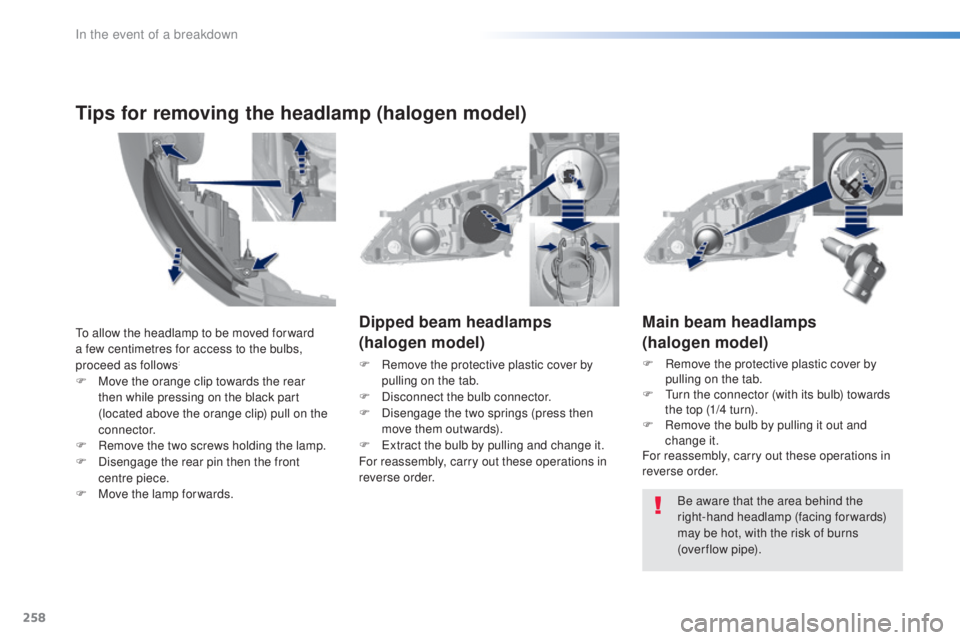
258
308_en_Chap08_en-cas-de-panne_ed02-2015
Main beam headlamps
(halogen model)
F Remove the protective plastic cover by
p
ulling on the tab.
F
t
ur
n the connector (with its bulb) towards
the top (1/4 turn).
F
Re
move the bulb by pulling it out and
change it.
For reassembly, carry out these operations in
reverse order.
Dipped beam headlamps
(halogen model)
F Remove the protective plastic cover by
p
ulling on the tab.
F
Di
sconnect the bulb connector.
F
Disenga
ge the two springs (press then
move them outwards).
F
e
xt
ract the bulb by pulling and change it.
For reassembly, carry out these operations in
reverse order.
Be aware that the area behind the
right-hand headlamp (facing forwards)
may be hot, with the risk of burns
(over flow
p
ipe).
to al
low the headlamp to be moved for ward
a few centimetres for access to the bulbs,
proceed as follows:
F Move the orange clip towards the rear
t hen while pressing on the black part
(located above the orange clip) pull on the
connector.
F
Re
move the two screws holding the lamp.
F
Disenga
ge the rear pin then the front
centre piece.
F
Mov
e the lamp for wards.
Tips for removing the headlamp (halogen model)
In the event of a breakdown
Page 277 of 398
275
308_en_Chap08_en-cas-de-panne_ed02-2015
to w i n gProcedure for having your vehicle towed or for towing another vehicle using a removable towing eye.
Access to the tooling
the towing eye is installed in the boot under
t h e f l o o r.
to ga
in access to it:
F
op
en the boot,
F
ra
ise the floor,
F
re
move the towing eye from the holder. Put the gear lever into neutral.
the f
ailure to follow this requirement
may lead to damage to components
of the braking system and the lack
of braking assistance on restarting
the
eng
ine.
F On t he front bumper, press the cover
(as s hown above) to unclip it.
F
Sc
rew the towing eye in fully.
F
In
stall the towing arm.
F
Sw
itch on the hazard warning lamps on the
towed vehicle.
F
Mov
e off gently and drive slowly over a
short distance only.
Towing your vehicle
8
In the event of a breakdown
Page 278 of 398
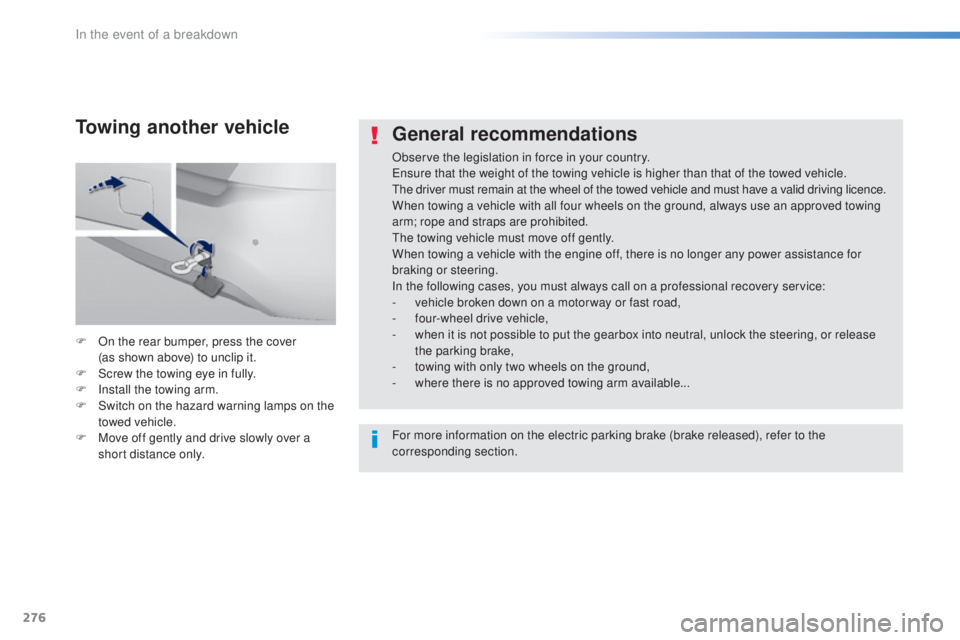
276
308_en_Chap08_en-cas-de-panne_ed02-2015
General recommendations
Observe the legislation in force in your country.ens
ure that the weight of the towing vehicle is higher than that of the towed vehicle.
the d
river must remain at the wheel of the towed vehicle and must have a valid driving licence.
When towing a vehicle with all four wheels on the ground, always use an approved towing
arm; rope and straps are prohibited.
the t
owing vehicle must move off gently.
When towing a vehicle with the engine off, there is no longer any power assistance for
braking or steering.
In the following cases, you must always call on a professional recovery service:
-
ve
hicle broken down on a motor way or fast road,
-
fou
r-wheel drive vehicle,
-
wh
en it is not possible to put the gearbox into neutral, unlock the steering, or release
the parking brake,
-
to
wing with only two wheels on the ground,
-
wh
ere there is no approved towing arm available...
F
On t
he rear bumper, press the cover
(as
s
hown above) to unclip it.
F
Sc
rew the towing eye in fully.
F
In
stall the towing arm.
F
Sw
itch on the hazard warning lamps on the
towed vehicle.
F
Mov
e off gently and drive slowly over a
short distance only.
Towing another vehicle
For more information on the electric parking brake (brake released), refer to the
corresponding section.
In the event of a breakdown
Page 283 of 398
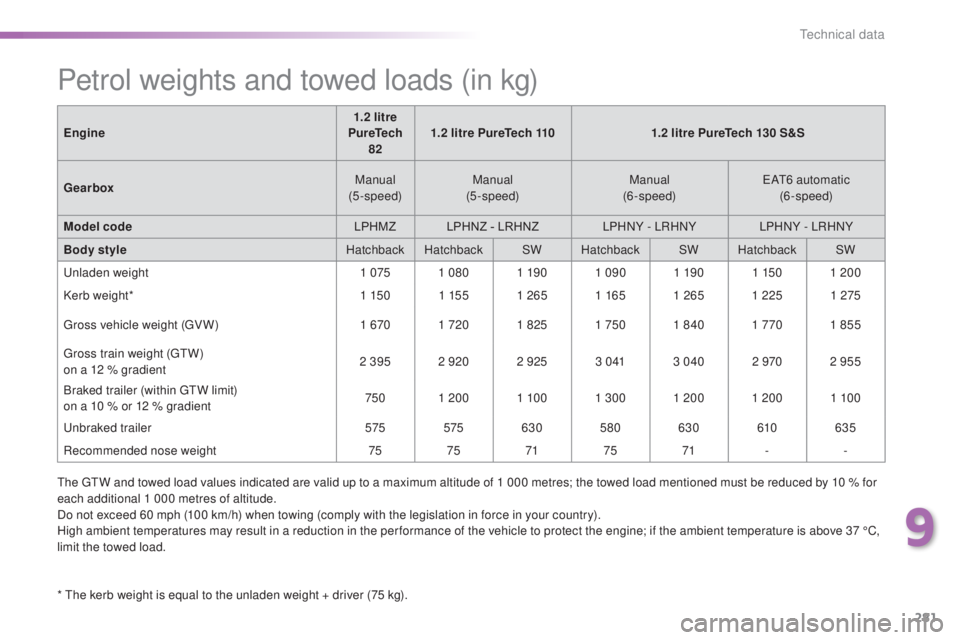
281
308_en_Chap09_caracteristiques-techniques_ed02-2015
Petrol weights and towed loads (in kg)
* the kerb weight is equal to the unladen weight + driver (75 kg).
En gine
1.2 litre
PureTech 82 1.2 litre PureTech 110
1.2 litre PureTech 130 S&S
Gearbox Manual
(5-speed) Manual
(5-speed) Manual
(6-speed)
eAt6 au
tomatic
(6-speed)
Model code LPHMZLPHNZ - LRHNZ LPHNY - LRHNY LPHNY - LRHNY
Body style Hatchback HatchbackSWHatchback SWHatchback SW
unl
aden weight
1 0751 080 1 19 01 090 1 19 01 1501 200
Kerb weight* 1 150 1 1551 2651 1651 265 1 225 1 275
gro
ss vehicle weight (
gV W
)
1 6701 720 1 825 1 7501 840 1 7701 855
gro
ss train weight (
gtW)
o
n a 12 % gradient
2 395 2 920 2 925
3 0 413 040 2 9702 955
Braked trailer (within
g
t
W li
mit)
on a 10 % or 12 % gradient 750
1 200 1 10 01 300 1 200 1 200 1 10 0
unbr
aked trailer
575 575630580 630 610635
Recommended nose weight 7575 7175 71 --
the g
t
W an
d towed load values indicated are valid up to a maximum altitude of 1 000 metres; the towed load mentioned must be reduced by 10 % for
each additional 1 000 metres of altitude.
Do not exceed 60 mph (100 km/h) when towing (comply with the legislation in force in your country).
High ambient temperatures may result in a reduction in the per formance of the vehicle to protect the engine; if the ambient temperature is above 37 °C,
limit the towed load.
9
technical data
Page 284 of 398
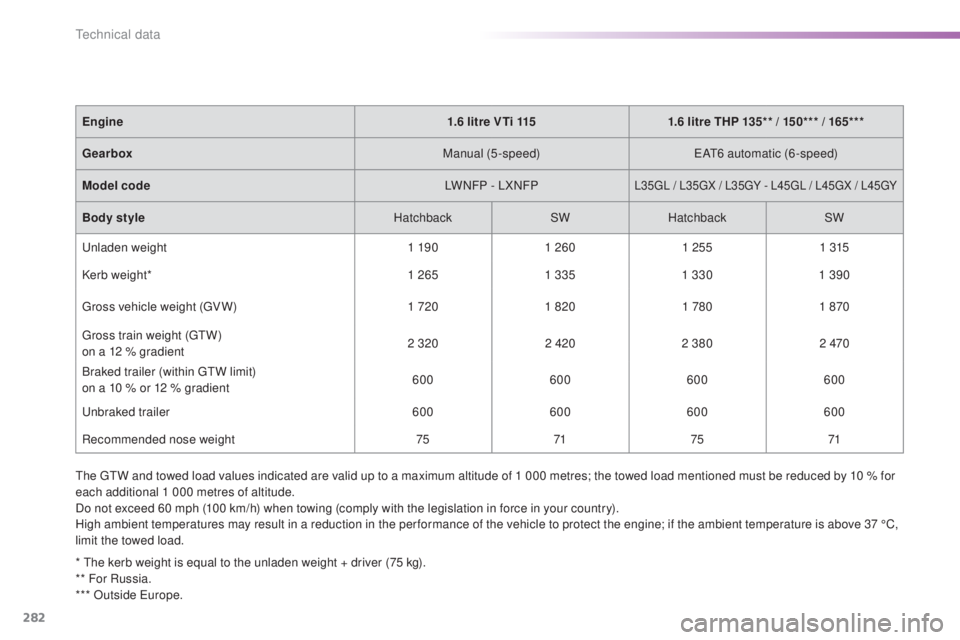
282
308_en_Chap09_caracteristiques-techniques_ed02-2015
the gtW and towed load values indicated are valid up to a maximum altitude of 1 000 metres; the towed load mentioned must be reduced by 10 % for
each additional 1 000 metres of altitude.
Do not exceed 60 mph (100 km/h) when towing (comply with the legislation in force in your country).
High ambient temperatures may result in a reduction in the per formance of the vehicle to protect the engine; if the ambient temperature is above 37 °C,
limit the towed load.
*
the k
erb weight is equal to the unladen weight + driver (75 kg).
** For Russia.
*** Outside
eur
ope.
Engine
1.6 litre VTi 1151.6 litre THP 135** / 150*** / 165***
Gearbox Manual (5-speed)
eAt6 au
tomatic (6-speed)
Model code LWNFP - LXNFP
L35gL / L35gX / L35gY - L4 5gL / L4 5gX / L4 5gY
Body style HatchbackSWHatchback SW
unl
aden weight 1 19 01 260 1 255 1 315
Kerb weight* 1 2651 335 1 3301 390
gro
ss vehicle weight (
gV W
) 1 7201 820 1 780 1 870
gro
ss train weight (
gtW)
o
n a 12 % gradient 2 320
2 4202 380 2 470
Braked trailer (within
g
t
W li
mit)
on a 10 % or 12 % gradient 600
600600600
unbr
aked trailer 600600600600
Recommended nose weight 757175 71
technical data
Page 285 of 398

283
308_en_Chap09_caracteristiques-techniques_ed02-2015
the gtW and towed load values indicated are valid up to a maximum altitude of 1 000 metres; the towed load mentioned must be reduced by 10 % for
each additional 1 000 metres of altitude.
Do not exceed 60 mph (100 km/h) when towing (comply with the legislation in force in your country).
High ambient temperatures may result in a reduction in the per formance of the vehicle to protect the engine; if the ambient temperature is above 37 °C,
limit the towed load.
*
the k
erb weight is equal to the unladen weight + driver (75 kg).
Petrol gt and gti we ights and towed loads (in kg)
Engine 1.6 litre THP 205 S&S
GT 1.6 litre THP 250 / 270 S&S
GTi
Gearbox Manual (6-speed)Manual (6-speed)
Model code L35
gt - L
45
gtL3
5
gP / L3
5
gN
Bo
dy style HatchbackSWHatchback
unl
aden weight 1 2001 3151 205
Kerb weight* 1 2751 390 1 280
gro
ss vehicle weight (
gV W
) 1 7901 880 1 790
gro
ss train weight (
gtW)
o
n a 12 % gradient 3 19 0
3 180 -
Braked trailer (within
g
t
W li
mit)
on a 10 % or 12 % gradient 1 400
1 300 -
unbr
aked trailer 635695 -
Recommended nose weight 7571 -
9
technical data
Page 290 of 398
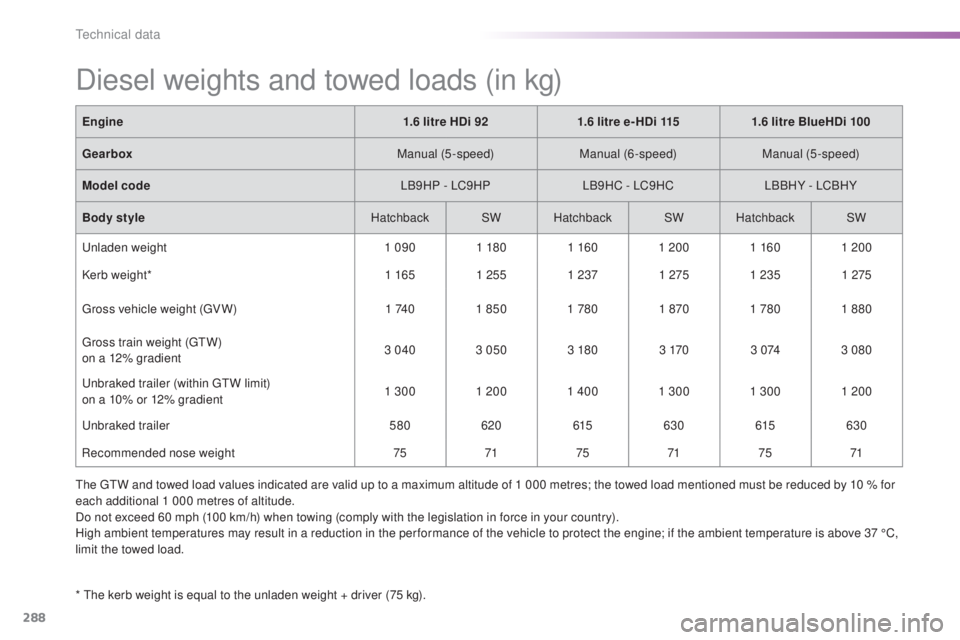
288
308_en_Chap09_caracteristiques-techniques_ed02-2015
Diesel weights and towed loads (in kg)
* the kerb weight is equal to the unladen weight + driver (75 kg).
En gine
1.6 litre HDi 921.6 litre e- HDi 115 1.6 litre BlueHDi 100
Gearbox Manual (5-speed)Manual (6-speed) Manual (5-speed)
Model code LB9HP - LC9HPLB9HC - LC9HC LBBHY - LCBHY
Body style HatchbackSWHatchback SWHatchback SW
unl
aden weight
1 0901 1801 1601 200 1 1601 200
Kerb weight* 1 1651 255 1 2371 2751 235 1 275
gro
ss vehicle weight (
gV W
)
1 74 01 850 1 780 1 8701 780 1 880
gro
ss train weight (
gtW)
o
n a 12% gradient
3 040
3 050 3 180 3 1703 0 743 080
unb
raked trailer (within
g
t
W li
mit)
on a 10% or 12% gradient 1 300 1 200 1 400 1 300 1 300 1 200
unbr
aked trailer
580620 615630 615630
Recommended nose weight 757175 7175 71
the g
t
W an
d towed load values indicated are valid up to a maximum altitude of 1 000 metres; the towed load mentioned must be reduced by 10 % for
each additional 1 000 metres of altitude.
Do not exceed 60 mph (100 km/h) when towing (comply with the legislation in force in your country).
High ambient temperatures may result in a reduction in the per formance of the vehicle to protect the engine; if the ambient temperature is above 37 °C,
limit the towed load.
technical data